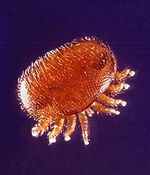Difference between revisions of "Varroa destructor"
Jump to navigation
Jump to search
| Line 3: | Line 3: | ||
{{Taxobox | {{Taxobox | ||
| − | |name =''Varroa destructor'' | + | |name = ''Varroa destructor'' |
| − | |phylum =Arthropoda | + | |phylum = [[:Category:Arthropods|Arthropoda]] |
| − | |class =Arachnida | + | |class = [[:Category:Arachnida|Arachnida]] |
| − | |order =Mesostigmata | + | |order = Mesostigmata |
| − | |family =Varroidae | + | |family = Varroidae |
| − | |genus =Varroa | + | |genus = Varroa |
| − | |species =''V.destructor'' | + | |species = ''V.destructor'' |
}} | }} | ||
Revision as of 11:31, 29 July 2010
| This article has been peer reviewed but is awaiting expert review. If you would like to help with this, please see more information about expert reviewing. |
| Varroa destructor | |
|---|---|
| Phylum | Arthropoda |
| Class | Arachnida |
| Order | Mesostigmata |
| Family | Varroidae |
| Genus | Varroa |
| Species | V.destructor |
| Also known as: | Honeybee mite |
The Varroa destructor mite is an external mite of honey bees. It causes varroatosis, which is no longer a notifiable disease in the UK.
Identification
The mite is oval in shape and 1-1.5mm in length. It is reddish-brown in colour and has 8 legs.
Life cycle
The mite has a 10 day life cycle. Eggs are laid in the hive and develop with the brood cells into mites.
Pathogenesis
The mites are blood-sucking, feeding on the bees and leaving open wounds. This weakens adult bees and damages growing larval bees, resulting in deformities.
Control
Acaricidal strips can be hung between combs. Mites should be monitored and treated if widespread. Colonies in an apiary should be destroyed if there is an isolated outbreak.

